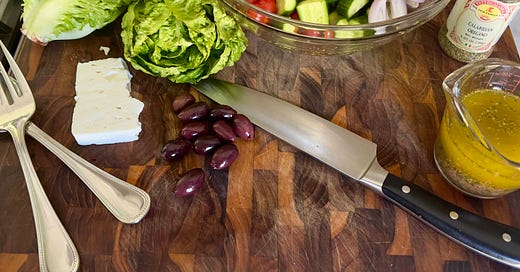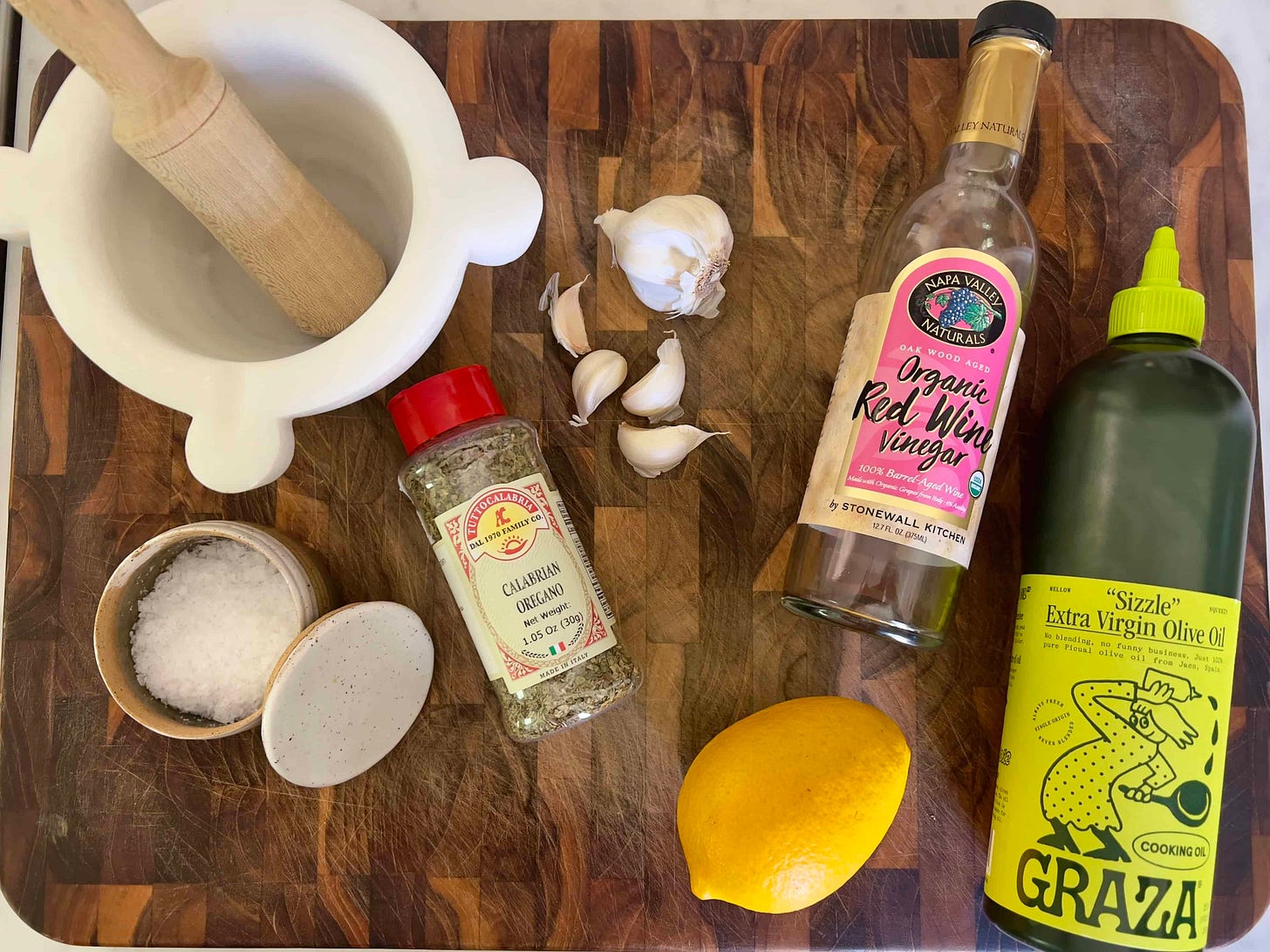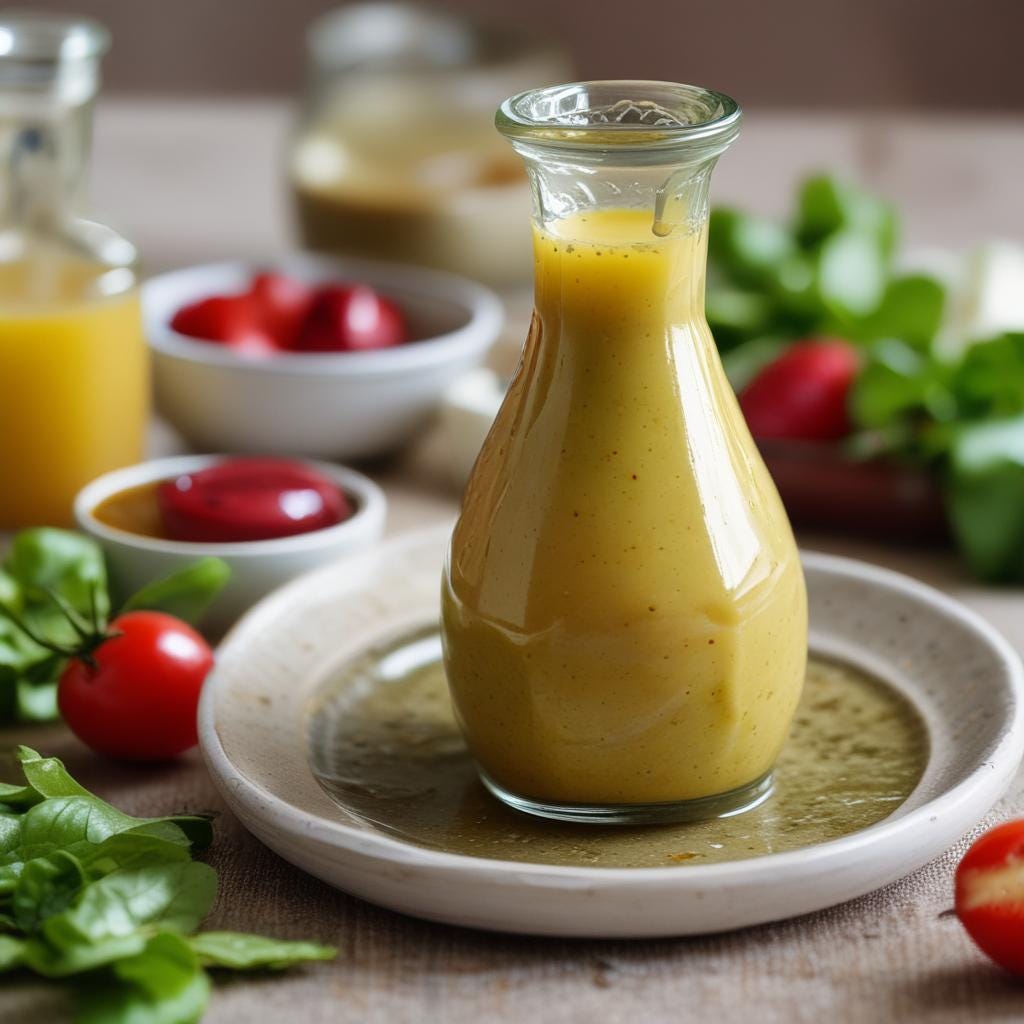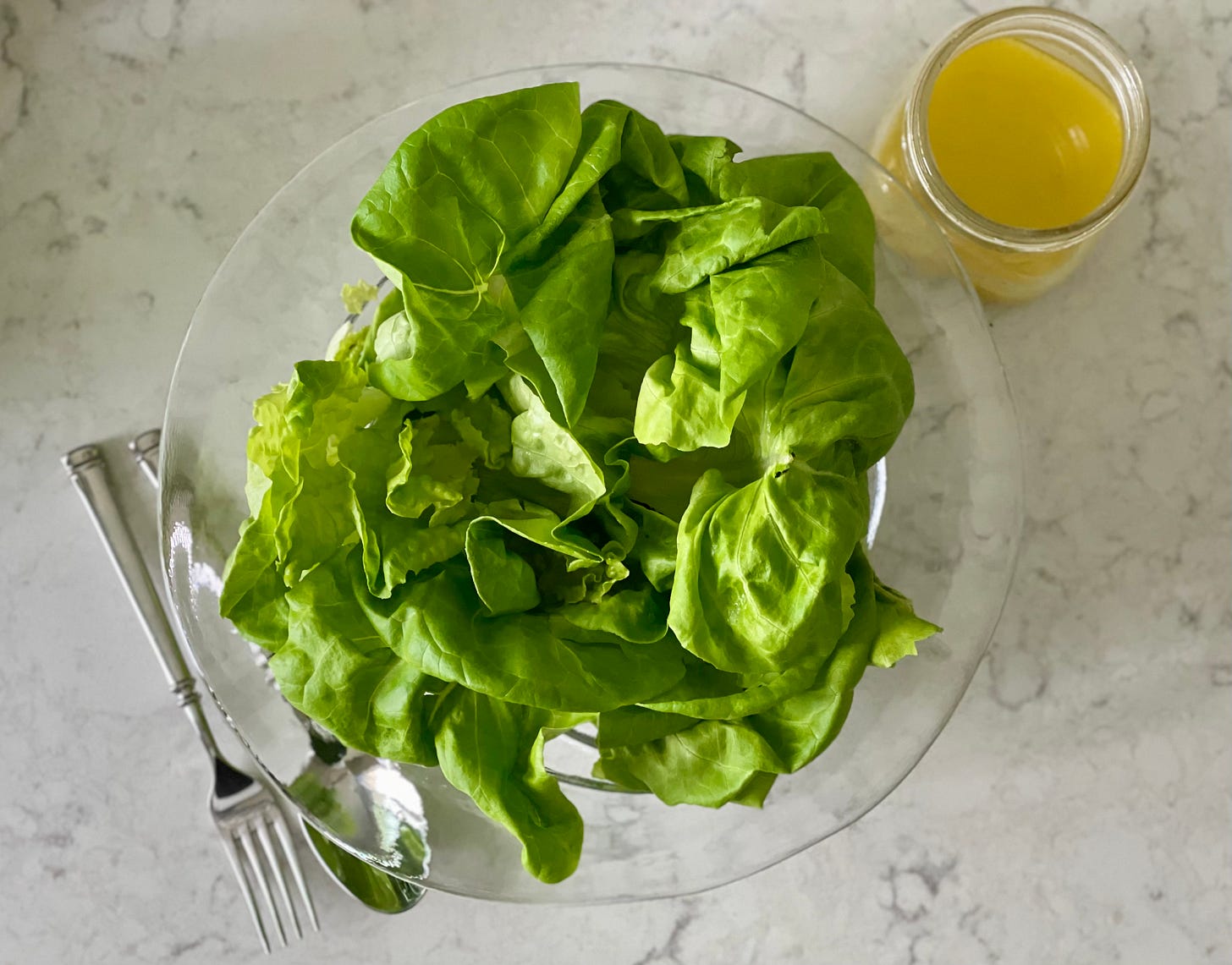Happy Friday! As the weather warms, it’s kind of a natural progression to start eating lighter and fresher to take advantage of the produce that starts appearing all around us. But I think we also do it because we don’t have that hibernation thing going on… we don’t crave warm cozy meals in hot weather.
Plus, we’re on sort of a health kick lately, so we’re trying to increase our plant-based intake, eat plenty of healthy protein, and drink lots of water. Listen, we’re still gonna have a burger every once in a while, but it’s all about balance. So this week, we thought it would be helpful to give you a few of our favorite vinaigrette tips, in case you’re eating a lot of leafy greens like we are.
GREEK DINER STYLE VINAIGRETTE (AKA LOTS OF DRIED OREGANO)
AU: My ol’ standby salad dressing is a shallot vinaigrette that is very much in line with Elizabeth’s recipe below… but lately I’ve been on a Greek Salad binge, and this vinaigrette is… dare I say… kind of perfect for it.
It reminds me of the classic, zingy, dried-oregano-imbued salad dressings you find at a classic Greek Diner. And if you’ve never been to a Greek diner, get thee to New Jersey asap!
EK: Mmmmm! That looks so good. Speaking of Greek diners, my favorite thing about getting a Greek salad at an old-world diner is the extra zing that is the chunk of soft, salty feta sprinkled with a generous pinch of dried oregano and a drizzle of EVOO on top!
AU: Yes—can’t beat it! Like so many things in life, a vinaigrette is about balance. You want it zippy and tart, but not so much that your lips pucker. You want it to coat the ingredients in your salad without weighing them down. You want it to be both acidic and well-rounded all at the same time. (If this sounds like your Hinge profile, you may be searching for a salad dressing, and not a date.)-
EK: LOL!!! Is this a comedy routine or a food newsletter?
AU: Haha Just seeing if people are actually reading. The key to this vinaigrette is mashing the garlic cloves (4 of ‘em!) into a paste with a teaspoon of kosher salt. This is best done in a mortar and pestle, but if you don’t have one, you can use the side of your knife on the cutting board. The second best way is to grate the garlic cloves on a Microplane/rasp-style grater, but it doesn’t turn quite pasty enough. The reason the garlic paste is important is because it kind of emulsifies the dressing…
Next, you’re going to add what seems like A TON of dried oregano. Dried is important here, because of its very specific flavor (and also how many diners have you been to where they use fresh??). If you can find it, I really love this Italian Dried Oregano by Tutto Calabria. (I linked to the small size, but I usually buy the BIG mama one!)
Then you’ll add not just one, but TWO acids. The first is red wine vinegar. The gold standard of vinaigrettes if you ask me… The second acid is lemon juice. Using a combo of acids/vinegars is a great way to up your vinaigrette (and thus, salad) game. The lemon kind of rounds out the astringent red wine vinegar flavor without dulling the zippy tang.
While I love a tangy dressing, everything needs balance, so I add a teaspoon or two of honey to sweeten the dressing. It won’t be sweet, but it won’t be so acidic your lips pucker. This is when I also add any additional seasoning (Pssst: I like to add a half teaspoon of MSG to my vinaigrettes and it’s DELICIOUS!!!).
Then whisk in your oil. We talk a lot more about oil choices down below, but for this one, I use a mild olive oil. Anything too powerful, that you might use to finish a dish, is going to overpower your vinaigrette.
GREEK DINER-STYLE VINAIGRETTE
Makes ~3/4 cup
4 cloves garlic, peeled
1 teaspoon Kosher salt
1 tablespoon dried oregano (can use less, if desired)
3 tablespoons red wine vinegar
3 tablespoons lemon juice
1-2 teaspoons honey
1/2 cup olive oil or neutral oil
Freshly ground black pepper
Place garlic cloves and salt in a mortar-and-pestle, and smash into a very fine paste. Add dried oregano and mix to combine. Transfer garlic-and-oregano paste to bowl. Add red wine vinegar, lemon juice, and honey. Whisk to dissolve honey and distribute garlic/oregano. Slowly whisk in oil until the dressing is somewhat emulsified (it will separate the longer it sits). Season with freshly ground black pepper.
CLASSIC FRENCH VINAIGRETTE AND A SALADE VERTE
EK: The first bite of a simple salade verte in France was one of my pivotal culinary moments. I can still remember that whole buttery soft leaf—apparently it’s bad manners to cut your lettuce with a knife—that had just the right amount of mustardy-tangy-perfectly emulsified French dressing clinging to it.
As an American, I was used to Romaine lettuce and mesclun greens, which I could take or leave, but a simple bowl of Boston (a.k.a. Butter) lettuce leaves and a creamy yellow vinaigrette changed my feeling about une salade.
AU: Agreed! It’s like when you taste farm-fresh lettuce for the first time. There’s lettuce and then there’s LETTUCE—and the grocery store clamshells, while serviceable, are not where it’s at, baby.
EK: For years I tried to duplicate the salad. It was easy enough to find Boston lettuce or Butter lettuce, but perfecting the vinaigrette was another thing entirely.
Long before I started teaching cooking classes, I took one at the Institute of Culinary Education (ICE) in New York City, and my professor had spent lots of time in Paris. I begged her to teach me the secret to a perfectly emulsified French vinaigrette. She was happy to help me and said that the secret was to use waaayy more olive oil than I ever imagined.
AU: It’s counterintuitive, right? I grew up eating super-zingy, heavy-on-the-red-wine-vinegar dressings… and I love them still to this day. But there’s something about a balanced dressing that makes everything in your bowl pop with flavor.
EK: That’s so true, I was used to 50% vinegar and 50% oil! My “oil and vinegar dressing” was vinegar and oil!
I was skeptical that it would make that much difference. But once I tried her ratio of 3/4 cup of extra-virgin olive oil to 1/4 cup of vinegar, I had the thick creamy yellow vinaigrette of my French dreams.
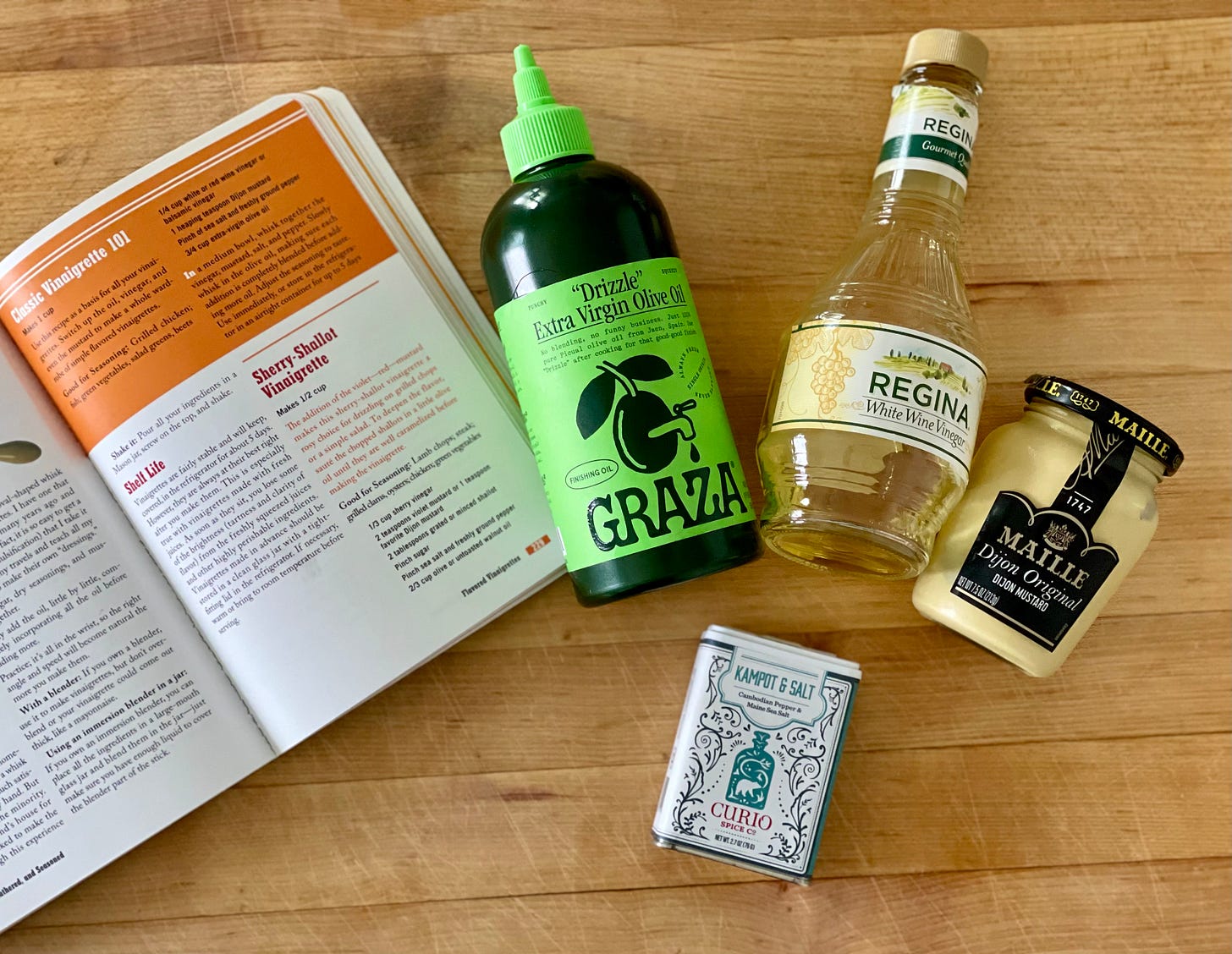
EK: At its purest, a vinaigrette is a mixture of three parts of oil to one part acid, generally vinegar, but sometimes lemon or other citrus juice. I use the 3-to-1 ratio when I’m looking to dial down the acid and increase the creamy mouth-feel with 1/4 cup vinegar and 3/4 cup oil.
But, since I grew up with those “super-zingy, heavy-on-the-red-wine-vinegar dressings” as AU calls them…most of the time I choose to make a 2-to-1 ratio with a 2/3 oil to 1/3 vinegar which produces a tangier vinaigrette.
If you make your own salad dressing, then you know what a difference it makes to the overall taste of your salad. It enhances, rather than buries, whatever you put it on and that includes a whole lot more than just leaves of lettuce. I use this classic mustard vinaigrette for grain and bean salads, like the French Lentil Salad and as a base for all kinds of flavor mix-ins to enhance veggies, meat, poulty, fish and shellfish. A good vinaigrette can take almost anything to the next level.
EK: The classic green salad is perfection in simplicity. Clean dry lettuce leaves and your homemade vinaigrette is all you need. No other veggies, no meat, nuts or cheese. Just beautiful fresh lettuce and your dressing. Once you get the hang of it, you may find yourself making one every night and craving it when you don’t!
Classic French Vinaigrette
1/4 cup white or red-wine vinegar
1 heaping teaspoon Dijon mustard
Pinch of sea salt and freshly ground pepper
3/4 cup extra-virgin olive oil,
In a medium bowl, whisk together the vinegar, mustard, salt, and pepper.
Slowly whisk the olive oil, making sure each addition is completely blended before adding more oil. Adjust the seasoning to taste.
Use immediately, or store in the refrigerator in an airtight container for up to five days.
Alternatively, you can pour all your ingredients in a mason jar, screw on the top and shake it, but you will need to shake it every time you want to use it to blend the ingredients together.
OILS
EK: So the big question is, do you use extra-virgin olive oil or not?
AU: I use olive oil for an everyday dressing, but if I’m making a Caesar dressing, for example, I like to use a more neutral-flavored oil like avocado oil. I think the EVOO can get too overwhelming…
EK: I personally use extra-virgin olive oil for everything from scrambling my morning eggs to making the vinaigrette and coating everything that I grill—oil the food, not the grates—using my Grilling Trilogy. I use it because I love the herbaceous sharp green flavors of a really nice first-press olive oil
To that end, when I’m making a vinaigrette I use my best extra-virgin olive oil.
If the flavor of extra-virgin olive oil is too strong for you, then you could use a more neutral tasting oil, like avocado oil or an untoasted nut oil—both walnut and hazelnut oil are terrific.
You can also buy a light olive oil, but remember light refers to the flavor profile not the calories. Light olive oil has the same calories, but has been refined to take out all of the flavor and that is the main reason why I don’t use this oil.
ACIDS
AU: My go-to acid is red wine vinegar (because I grew up loving it), but I find that mixing acids is a little way to make your vinaigrette have a big impact. So nowadays, I like to use a few tablespoons of vinegar (be it red wine, sherry, champagne, apple cider, rice, or white wine) AND lemon juice… I don’t know how to describe the end result other than it just tastes brighter and less of that pucker-your-lips vinegary bite…
EK: My collection of vinegars is almost as big as my collection of oils! I love them all and decide which one to use based on the flavor inspiration of the dish. For example, if it leans Southern, I use Apple Cider Vinegar, if I want it to be a little more sophisticated, I use Sherry or Champagne. I have a Tarragon white wine vinegar that I love for salads that I top with chicken, and red-wine vinegar is my everyday go-to.
AU: In the same vein as acids, I should shout out WATER here. Yes WATER! Rita Sodi adds a splash of water to her vinaigrette at the famous Via Carota, because it just lets the flavors open up and softens the vinegar. Kind of the same way a splash of water makes your whisky or bourbon really sing!
EMULSIFIERS
EK: One of the most difficult things when making a homemade vinaigrette is making an emulsion that holds tight so you don’t have to shake it every time you want to use it. Adding the oil last, and drizzling the oil slowly while whisking it into the vinegar and mustard works well but you have to be patient and take your time. And, the mustard really helps to hold it together. I rarely make a vinaigrette without good strong Dijon mustard,
AU: Dijon mustard is also my go-to… but sometimes I’ll use an egg yolk. Or, like in the Greek-Diner-Style Vinaigrette above, the garlic can emulsify the dressing if it’s mashed up in a mortar and pestle.
EK: I never thought of garlic that way. Now, I have to try it! You can also use a tablespoon of heavy cream or a touch of mayonnaise to keep the vinaigrette from separating. I love using heavy cream when I am making a vinaigrette for simple fresh fruits and vegetables especially when I use lemon or lime juice instead of vinegar as the dairy also softens the tartness.

